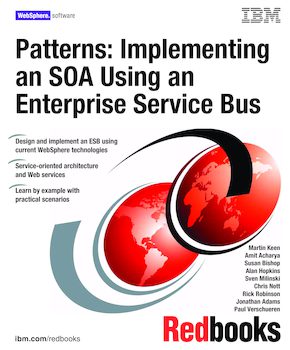Patterns: Implementing an SOA using an Enterprise Service Bus
An IBM Redbooks publication
Note: This is publication is now archived. For reference only.

Published on 25 July 2004
ISBN-10: 0738490008
ISBN-13: 9780738490007
IBM Form #: SG24-6346-00
Authors: Martin Keen, Amit Acharya, Susan Bishop, Alan Hopkins, Sven Milinski, Chris Nott, Rick Robinson, Jonathan Adams and Paul Verschueren
Many enterprises (large and small) are focused on increasing their business flexibility while simplifying their IT infrastructure in order to better meet their business objectives. The IBM on demand Operating Environment (odOE) defines a set of integration and infrastructure management capabilities that enterprises can use to achieve these challenging objectives. The odOE features of particular relevance to this IBM Redbooks publication are the use of a service-oriented architecture together with an Enterprise Service Bus. These are both necessary to achieve the goals of increased business flexibility and a simplified IT infrastructure. Many of these enterprises are determined to use proven architectures, designs and product mappings in order to speed their implementation and minimize their risk.
Patterns for e-business is a group of proven, reusable assets that can be used to increase the speed of developing and deploying e-business applications. This book focuses on how the service-oriented architecture profile of the Process Integration patterns can be used to start implementing service-oriented architecture using an Enterprise Service Bus.
Part 1 presents a description of service-oriented architecture and how it applies to Web services and e-business on demand. Emerging service-oriented architecture trends are also discussed.
Part 2 provides a detailed description of the Enterprise Service Bus (ESB) concept, and how this fits with the Patterns for e-business. Common usage scenarios, a minimum capability ESB, and ESB patterns are described. IBM product mappings are then applied to the ESB patterns.
Part 3 guides you through the process of implementing an Enterprise Service Bus using current IBM technologies. Router and Broker interactions within an Enterprise Service Bus are covered, along with off-the-bus service choreography and the Exposed ESB Gateway to enable interaction in an inter-enterprise environment.
An updated SOA profile, and a description of how to implement SOA solutions in WebSphere Application Server V6, is described in the new book "Patterns: SOA with an Enterprise Service Bus in WebSphere Application Server V6"
Part 1. Patterns for e-business and SOA
Chapter 1. Introduction to Patterns for e-business
Chapter 2. e-business on demand and service-oriented architecture
Chapter 3. Web services and service-oriented architecture
Part 2. Enterprise Service Bus
Chapter 4. Enterprise Service Bus and SOA patterns
Chapter 5. ESB and SOA component implementations
Chapter 6. Endpoint enablement roadmap
Part 3. Scenario implementation
Chapter 7. The business scenario used in this book
Chapter 8. Enterprise Service Bus: Router variation
Chapter 9. Enterprise Service Bus: Broker variation
Chapter 10. Business Service Choreography
Chapter 11. Exposed ESB Gateway composite pattern
Appendix A. Additional material
Appendix B. Configuring the scenario lab environment